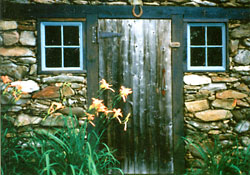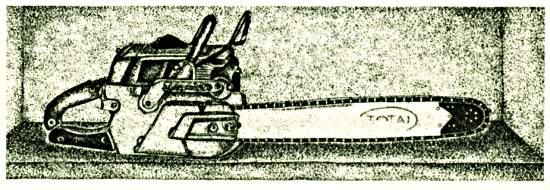
Louise Landes Levi
reviews
Sunswumthru a Building
by Bob Arnold
Origin Press, Guilford, VT. 2006. 125 pages .w. 22 b&w line drawings by Laurie Clark. Cover, author portrait and frontispiece photography by Susan Arnold
This review is about 4 printed pages long. It is copyright © Louise Landes Levi and Jacket magazine 2007.
1
I’m here in Venezuela, on tropical Isla Margarita, involved in usual & unusual Buddhist studies, not even sure I can really follow them, amid Bougainvillea, Heliconia & small green humming birds. I spend most of my time at Playa Saragoza or at my favorite refuge, also my office, when on the island Restaurante Casa di Esther.
2
It wld. seem slightly strange that I, traveler, hermit, accused, at times, of instability, but generally trusted, should be writing a review of Bob Arnold’s Sunswumthu A Building, his tribute to a lifetime of earth based activity, a life long marriage to his companion, muse & lover, often cited in this work, Susan Arnold, & his, according to the text, vast array of tools, the tools of the trade & others, unmentioned yet equally manifesting in the text.

Cabin by Bob Arnold
Photo copyright © Susan Arnold, 2006
paragraph 3
Here at Esther’s (synchronicity never fails to amaze) the history of Venezuelan Arts & Crafts, the tools of those crafts & the agricultural history of this island & the tools of that history line the walls, w. household items such as antique typewriters, telephones, sewing machines & irons, artistically placed on tables, shelves & the odd chest. Other subtle tools are also here, those relating to religious practice & archeology. Arnold wisely steers clear of those.
4
In Sunswumthru, 40 beautifully crafted chapters inform us of the principle tools in his life, those which have permitted him to live the legendary back woods life, to build not one but several homes (the descriptions of the building of those structures forming the narrative of the text) & to maintain himself as a survival of the beat culture that manifested in urban & suburban, middle class & working class milieu, & also in the exotic, even indulgent & highly ceremonial milieu of the rock culture in the 60s, sadly dwindling to a very few survivors, as the new millennium swings open the gates of fortune & we are left gasping at the ignorance, violence & subterfuge with which & by which we are surrounded.

|
|
Bob Arnold |
5
Bob has been a maverick of independent publishing, & of the marginal poet’s life, for nearly four decades, bringing to the attention of the world, for years through his beautifully designed catalogues, now through the internet, a vast array of authors, in translation & in the original tongue (see Longhouse publishers at http://www.longhousepoetry.com/), writing a monthly online diatribe or review of recent books & acquisitions (‘Wood Burners’), which he & his wife store in a stone treasure chest, called, not uncharacteristically, ‘the Long House’. Executor of the Cid Corman estate, he has recently compiled Origin, the Sixth Series, a final tribute to the poet who was, in many ways, Arnold’s mentor & also his partner in crime, the two collaborating on numerous projects of which this book is perhaps the final, as Charles Sandy, its generous, as I understand it, publisher was also the caretaker of Corman in the final stage.
6
Bob’s life is one of dedication to the book & to the word. It is also one of dedication to the tradition of the backwoods, to the stone builder’s trade, to the stone mason’s artistry, to a legacy inherited from his grandfather & his father, of builders & lumbermen, & now passed on to his son, Carson, who, following a self-school program, agrees to a year of assistantship, a lumberman’s apprentice, w. his father, the purpose of which will be the building of a studio & small ‘privy’ on their land, in So. Vermont.
7
What I learned, is that no matter how much I may have thought my father was an asshole to me while growing up, I was an asshole to Carson, and it took having a son of my own to see that father in my father could be me. I also spotted the other asshole — the one I was as a kid, working with the kid I was now working with. Was I that bad?
8
The juxtaposition of the tool as companion to the trade & the stories of Arnold’s life w. his living companion, Susan & his son & working partner Carson, bring forth the internal tools that have allowed him to sustain himself, under the grid so to speak in a period which has seen all but the most astute fall prey to the corporate.
9
The book is a witness to transition, to the natural evolution of the ‘studio’ — the design, the rafter & the roof , of the family & of duration itself, unfolding in the back woods of rural Vermont. In the hands of the poet & independent publisher, a being as isolated & as distant as I am fr. the life led by the Arnolds is easily able to experience it; indeed the book becomes a tool of the encounter.

|
|
Power Saw, drawing copyright © 2006 by Laurie Clark |
10
Sunswumthru is thus not only a record of the tools that have allowed Bob to sustain both his independence & the family trade — working tools are also the chapter names: ‘Ladder’, ‘Splitting Maul’, ‘Snow-Rake’, ‘Bellows’, ‘Jacks’, ‘Ash Pan’, ‘Wooden Spoon’, etc., but also the inner tools, diligence, patience, humor & above all, the perception of the poet, turning the microscopic into the cosmic & a lazy afternoon into a workman’s dream.
11
Surrounded by tools at Casa di Esthers, one notes that history is everywhere. The tool is a kind of historic sign, and the history of tools is also the history of a people. Bob’s book transforms the tool into a sign language that writes the story of his family & reveals the greater tool — of love — binding the worker to his task, the family to itself & the stencil to the window when a crack must be concealed.
12
The poet’s tool — & one cld.say Arnold is above all a poet, “One of America’s best poets” writes J.P. Seaton on the jacket of Arnold’s most recent chap Invent A Word — is of course his mind, his perceptual apparatus & the words, the literal ‘signs’ that bring his perception to formal manifestation.
13
Study this book, read Arnold & see if you don’t understand the deeper level of his mind by observing, with him, his tools, his family & the memories of the back woods he shares in this tender & yet highly practical collection of anecdotes, descriptions & portraits of those he has known & loved on River Road, Arnold’s personal & well cared for fraction of the fragile globe.
14
For those specifically interested in the tools described by Arnold (many of which are shown to the reader in delicate line drawings accompanying the text) the reader may also consult On Stone: A Builder’s Notebook, written two decades ago & for which the present volume, is a late-to-arrive but never-too-late companion. On Stone, the predecessor to this book, was also published by Origin & serves as a general reference guide to stone masonry & the stone builder’s trade.

|
|
Photo copyright © Susan Arnold, 2006 |
15
Building on the dream, constructing the homestead, inhabiting the house of dream, Arnold gives a wonderful sustainability to his design, yet reminds us, w. each new description — ‘Stencil Brushes’, ‘Typewriters’, ‘Wheelbarrow’ — of the movement of time through the hands of the builder.
16
By age fifty a carpenter needs a helper, needs a companion, needs someone he thinks he can teach something to. The wonder will be that he will be taught in return. The best books are endless — a feeling that there are no real answers, no real solution — that we are ever evolving but sticking to a course. Pages to be filled in later. A book as a tool, to be used from my life, to be given to another.
— Louise Landes Levi
Restaurante Casa di Esther, Pedro Gonzales, VE.
The Internet address of this page is http://jacketmagazine.com/33/levi-arnold.shtml